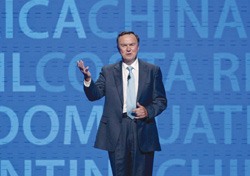Revenue Climbs Despite Tumult During Dukes Tenure
by May 25, 2012 6:18 pm 117 views

Editor’s Note: The following profile is part of a series originally published by Arkansas Business highlighting the CEOs of the 17 publicly traded companies headquartered in the state. The Northwest Arkansas Business Journal is running the profiles of the CEOs whose companies are headquartered in our coverage area as a service to our readers. The following profile was published in Arkansas Business on March 26.
Mike Duke had a rough start to his tenure as CEO of Wal-Mart Stores Inc.
On Feb. 1, 2009, Duke became the fourth CEO in Wal-Mart’s history and quickly faced his first hurdle: The company’s plan to overhaul its stores already was under way, but the plan would soon backfire. The strategy called for the Bentonville retail chain to redesign stores by offering fewer items for sale and to reshape “Action Alley,” the place where promotional items were pulled off the shelves and displayed.
But Wal-Mart’s core customers, Americans who make $40,000 to $70,000 annually, didn’t like the changes and voted with their wallets, propelling sales at dollar stores like Dollar General and Fred’s.
The failed strategy showed up on Wal-Mart’s financial reports under same-store sales, a metric that compares sales at stores that have been open at least a year and a key indicator of a retailer’s health. For its fiscal year that ended in January 2010, Wal-Mart’s U.S. same-store sales were down 0.2 percent. For the fiscal year that ended in January 2011, same-store sales in the U.S. were down 1.6 percent.
“Wal-Mart focused on this fancy remodeling program and fancy apparel, and it’s totally off track with their whole business,” Howard Davidowitz, chairman of Davidowitz & Associates Inc., a retail consulting and investment banking firm in New York, told Arkansas Business in February 2011. “I think Wal-Mart has lost their way.”
Duke announced in February 2011 a four-point plan to improve U.S. sales, which included returning to its “Every Day Low Price” strategy. The plan seems to have worked. For the most recent fiscal year that ended Jan. 31, same-store sales in the U.S. were up 0.2 percent.
“Our price leadership is making a difference across the United States, as many families are settling into a new normal,” Duke said in a Feb. 21 news release about the earnings. “Core customers remain cautious about their finances, and they rely on Wal-Mart’s [Every Day Low Price] promise to help them manage through today’s economic challenges.”
Coming to Wal-Mart
Duke, 62, grew up in a rural county just southwest of Atlanta, according to a September 2010 article in Fortune.
His father drove a truck and his mother was a homemaker, the article said. Duke’s chores included tending the corn and tomatoes on his family’s land.
“I concluded at about 12 years old that I did not want to do that for the rest of my life,” Duke said in the article.
In 1971, Duke graduated from Georgia Tech with a bachelor’s degree in industrial engineering, according to The Associated Press. He then started his retail career in 1972, and worked for the next 23 years with Federated Department Stores and May Department Stores.
Joining Wal-Mart
In July 1995, Duke was hired by Wal-Mart. He held several positions in logistics, distribution and administration. In April 2003, Duke was promoted to president and CEO of Wal-Mart’s U.S. division. Two years later, he was named vice chairman of the international division.
“When I met him, at first I thought, ‘Wow! He runs International at Wal-Mart?’” PepsiCo CEO Indra Nooyi said in the Fortune article of her first impression of Duke. “And then you sit down with him and you find that this person, who’s very unassuming, is a very, very global thinker, a very worldly person.”
Under Duke’s leadership, Wal-Mart’s international division’s revenue grew from $39.8 billion for the fiscal year that ended in January 2006 to $98.64 billion for the fiscal year that ended in January 2009. The number of its international stores also increased from 2,158 to 3,615 during that period.
Duke is known for his people skills, according to a February 2009 article in Fortune.
“He’s the kind of guy who will put his arm around you and help you through things,” Andy Bond, the head of Wal-Mart’s U.K. division, said. “He told me that decisions are best slept on, and to try to look at things from other people’s perspectives.”
CEO
After Duke became CEO in February 2009, expanding Wal-Mart’s global footprint was a top priority.
One of its biggest purchases came in 2010 when it spent $2.2 billion for 51 percent of South Africa’s Massmart. Its international sales continued to grow. Revenue jumped 15.2 percent to $125.9 billion for the fiscal year that ended in January.
It also has tried to beef up its online shopping. Although Wal-Mart doesn’t report its online sales separately, the Internet Retailer, an online retail industry website, estimated Wal-Mart’s online sales were $4.1 billion, making it the sixth-largest online retailer in the U.S.
In 2011, Wal-Mart spent hundreds of millions of dollars buying experienced social media and e-commerce companies to run Wal-Mart’s technology initiatives, including the social and mobile media company Kosmix of Mountain View, Calif., for $300 million.
Under Duke, Wal-Mart continues to grow its total revenue. It shattered its own revenue record for the fiscal year that ended Jan. 31, with $443.85 billion, up 5.9 percent from the previous year. It also was the No. 1 company for revenue on the Fortune 500 list in 2011.
“Today, every segment of our business is stronger than it was a year ago, and we’re in a great position” for the current fiscal year, Duke said in the Feb. 21 news release.
